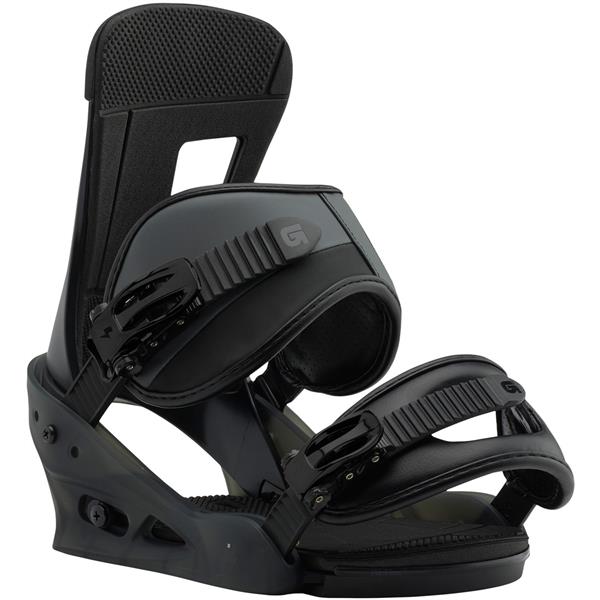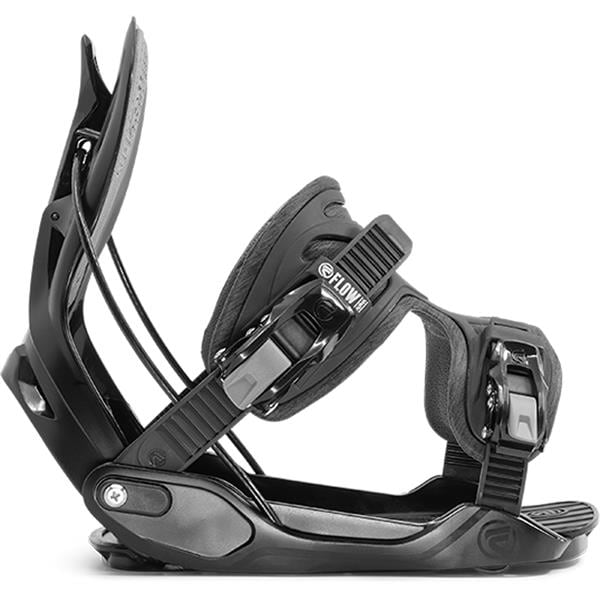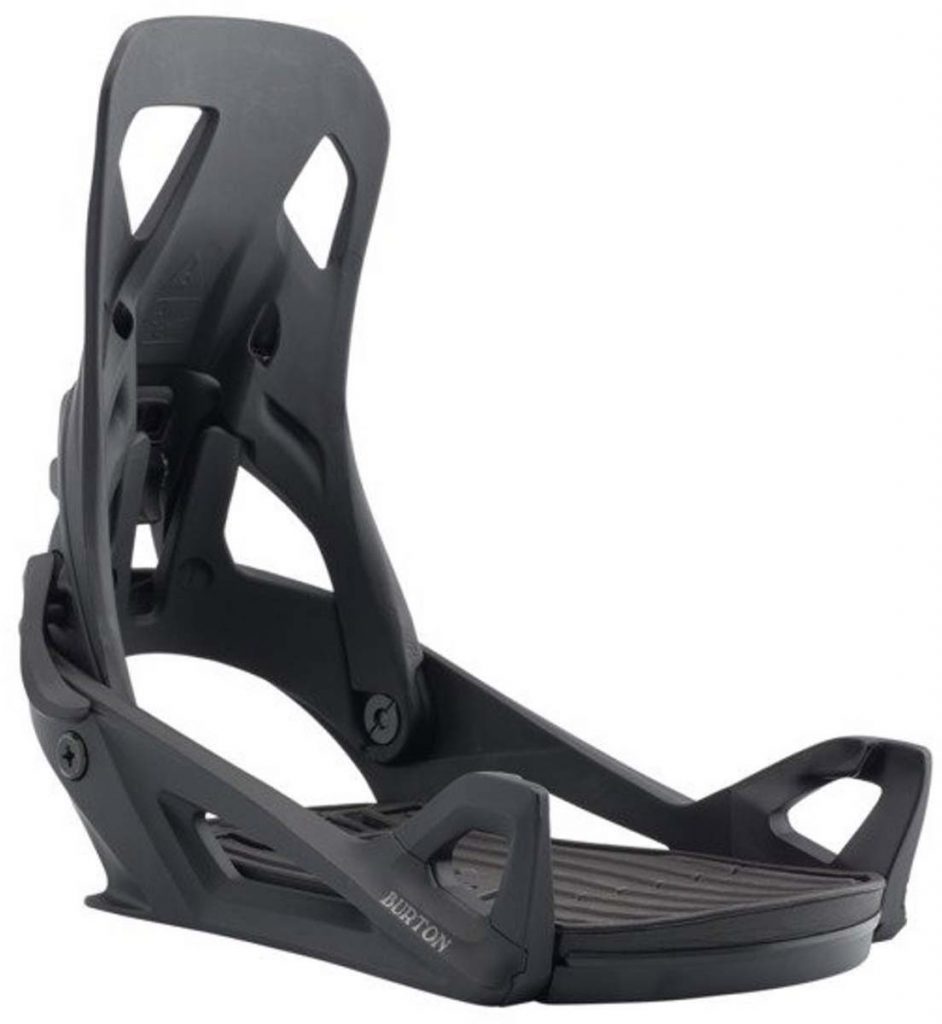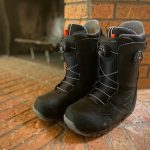There is more to picking out snowboard bindings than choosing a color that matches your snowboarding gear. When you are first learning how to choose snowboard bindings, it is important to understand how your boot will be secured to the binding, as well as the flex rating and if it will be compatible with your snowboard.
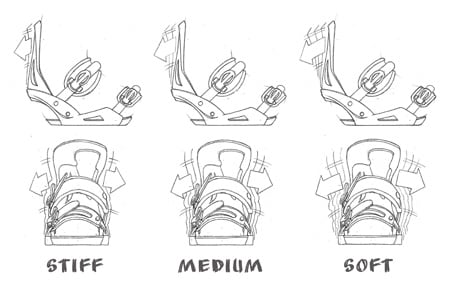
Binding Flex
Many don’t realize that snowboard bindings have flex ratings. These ratings indicate what style of riding the binding is designed for. Most brands rate their bindings on a scale of one to ten, one being the softest and ten being the stiffest. It is important to pick a binding that matches the type of riding you’ll be doing the most.
Binding Flex for Freestyle Riders
Freestyle riders tend to go with a softer flex. This is because the softer flex allows greater room for error and easier landings. It also allows the rider to tweak grabs and apply pressure to certain parts of their board when in the terrain park.
If you typically stay in the park all day and like to ride really soft flexing boards for easy buttering, then a softer flexing binding could be the way to go.
However, a lot of freestyle riders like to use the rest of the mountain as their playground. This can be due to the fact that their friends aren’t ready for the terrain park, or that they enjoy more natural features. If this is the case, a medium to soft flexing binding may be the way to go.
If you find yourself hitting larger jumps or the halfpipe, it’s usually preferred to have a slightly stiffer binding flex. A medium flex in this case is probably better. You don’t want to go too stiff because you’ll still want to tweak grabs and want some forgiveness on landings, but that extra stiffness can help make your landings more stable.
Binding Flex for All Mountain Riders
All-mountain riders like to do a bit of everything and it is important that their gear reflects this. This is where the medium to medium-stiff flex bindings come into play. This flex allows you to do everything on one set of bindings all in the same day.
Some all-mountain riders may go slightly softer or slightly stiffer depending on their riding preference. If you are one to spend more time in the park than on trails, it may be a good idea to go with a softer flex. If you like high speeds, carving, and the backcountry and only go through the terrain park once or twice a day, a stiffer flex may be better for you.
Binding Flex for Free-Riders
Riders who use a stiff flexing binding typically live in the backcountry. You may find them hucking huge cliffs and bombing descents that you can only reach from a helicopter. The binding stiffness helps the board be super-responsive, giving the rider more control. Riders who prefer a bit more forgiveness can go with a medium-stiff rating.
Binding Flex for Beginners
Snowboard bindings with a softer flex rating are going to be preferred by beginners. This is because they are the most forgiving of errors.
Types of Bindings
There is a lot of variety in binding features. Choosing between them comes down to your experience, riding style, and of course, how much you want to pay.
Strap-In Bindings
Strap-in bindings are the most common type of binding. This type of binding has been used for a long time simply because it works great. Two straps go over the top of your boot and tighten down to your preference using a ratcheting mechanism. They are extremely easy to use and keep your feet secure in the binding.
Rear-Entry Bindings
Rear-entry bindings were created so riders can strap into their bindings quicker. The binding highback pops open so you can slide your foot into the straps which should already be tightened to your preference. The highback will then need to be snapped back into place, securing your foot.
Although they sound like a breeze, rear-entry bindings can be tricky for beginners. This is because beginners have a hard time finding their balance and end up sitting down when strapping into their bindings. Rear-entry bindings work best when strapping in standing up or even when there is a bench to sit on, which can be hard to come by at a lot of ski areas.
Burton Step-On Bindings
Burton Step-On bindings allow you to secure your feet quickly and with ease. As the name suggests, all you do is step on the binding and click your heel into place. It is important to note that you can only use Burton Step-On boots with these bindings.
Binding Compatibility with Boots
Snowboard bindings come in small, medium, and large sizes. It is important to purchase the right size binding for your boots. The first thing you can do is check the manufacturer’s binding size chart to see what size binding you’ll need.
Next, you should strap your boots into your bindings to make sure they fit correctly. The binding straps should comfortably fit over the boots and you shouldn’t have any trouble tightening them down. If the strap ladder does not reach the ratcheting mechanism or is bottoming out, it may need to be adjusted. Binding straps typically adjust from both sides. This helps center the strap over your boot. You know you have the right size binding if the heel of your boot fits snugly and there is no additional play once strapped in.
Lastly, you should make sure your binding flex matches the flex of your boots. It would not make sense to have a stiff binding and a soft boot and vice versa. Check out this post if you want to learn how to choose the correct snowboard boots for your riding style and setup.
Binding Compatibility with Snowboards
Purchasing a binding that is compatible with your snowboard is really important for obvious reasons. Getting bindings that don’t fit your snowboard isn’t going to be very useful.
There are four binding mounting systems used by snowboarding manufacturers. Most of these systems are compatible with each other. If you find one of the systems below not compatible with your snowboard, many manufacturers offer separate discs that you can buy to make your bindings compatible with a particular system.
The main difference between binding mounting systems is the inserts patterns. The inserts are what you use to screw your bindings to your snowboard. Some systems will give more options than others in terms of stance width, angles, and the position of the bindings across the width of the board.
4x4 Pattern
The first is known as the 4x4 pattern. This pattern has two rows of holes with each row being four centimeters apart. Every hole on each row is also 4 centimeters apart. There are usually three holes per row.
This insert pattern is now very uncommon as most boards now come with the 2x4 pattern or the Channel system if it is a Burton board. You may still find this pattern on some cheaper or youth boards.
Bindings that attach to the snowboard with four screws will be compatible with this system.
2x4 Pattern
The next is the 2x4 pattern. This one is similar to the 4x4 pattern except that the holes on the rows are only two centimeters apart. This allows for more stance width options than the 4x4 pattern. There are usually six holes per row.
This is the most common pattern for non-Burton boards. Bindings that attach to the snowboard with four screws will be compatible with this system.
3-Hole Pattern
Most snowboard brands use the first two systems to mount their bindings. However, Burton always has to be different. The first of the Burton systems is the 3-hole or 3D pattern.
This system uses 3 screws to mount the bindings in a triangular pattern. You will likely find this system on older Burton boards.
Channel System
Burton’s newest mounting system is the channel system. The bindings are attached to a track insert using two screws, one on each side of the binding. Once the bindings are attached to the track insert, you can move the inserts along the channel until you find the desired position. Not only do the bindings move to adjust the width of your stance, but they also allow you to vertically adjust your bindings on your board. You can also easily adjust the angle at which your feet sit.
Once the desired position is found you will need to tighten the two screws into place. Since the channel system was invented by Burton, a Burton EST specific binding will work the best.


